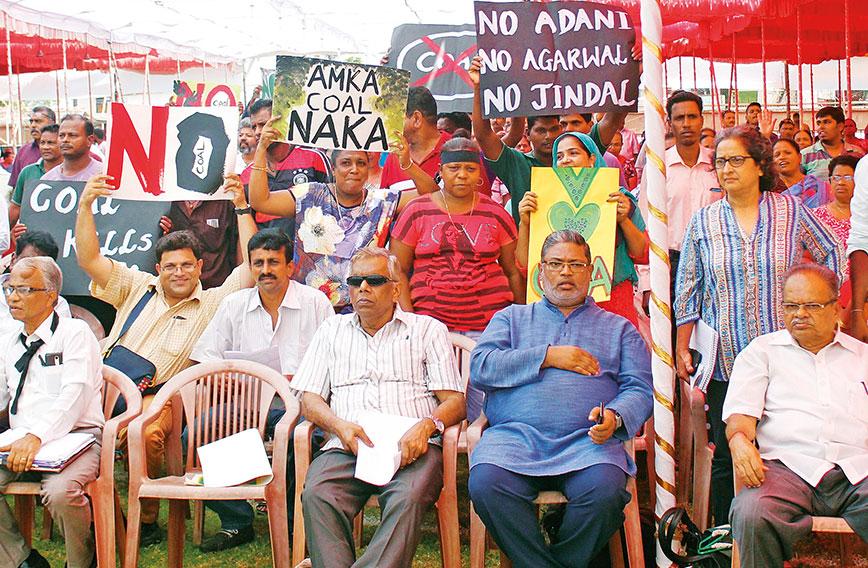
Goa's gritty gram sabhas fight back
Derek Almeida, Panaji
When the state government in Goa drew up plans to make the Mormugao Port a hub for importing coal and transporting it to steel factories in Karnataka, it ran into opposition it had never really expected. At the public hearings on the proposal, doctors, lawyers and scientists tore into officials with information and questions for which they had no real answers.
The high-decibel public hearings made headlines. But far from the spotlight, ordinary, less-articulate Goan villagers in gram sabha meetings had already expressed their opposition to the coal hub plan. Transportation of coal had caused serious environmental problems for them, with fine coal dust settling on their homes and fields. Making Mormugao a major hub was going to worsen the situation for them and they weren’t going to stand for it.
Similarly, the decision of the Union government to develop seven rivers in the state, including the Zuari and Mandovi, has been opposed. The government’s plan is to develop inland waterways and build jetties to enable coastal shipping and boost tourism. But people see this as an infringement on their traditional rights.
It is such opposition that has perhaps prompted the Chief Minister, Manohar Parrikar, to clear the air. He has declared that the coal hub can only be expanded if pollution control measures are first put in place. He has also clarified that development of rivers remains in the control of the state government.
Gram sabhas in Goa have come to be the barometer of people’s anger against development decisions that affect the quality of their lives and endanger their traditional livelihoods. Like the coal hub at Mormugao, the government’s plans are invariably drawn up without taking the people into confidence. Public hearings come later in the process and are almost an afterthought. The gram sabhas are asking for a say in major development decisions because, like coal dust, they finally impact life in the villages.
The gram sabha or village assembly is the lowest tier of rural democratic institutions, coming after the panchayat. They are only empowered to deal with minor, local requirements. But with the powers of the panchayat being encroached on by the state government, it is through the gram sabha that people are expressing dissent.
In Chandor village, once the capital of the Kadamba dynasty, villagers are pitted against the government with the panchayat caught in between. The bone of contention is a state highway slated for widening, a move vociferously opposed by the people who are convinced this will convert their village into a corridor for heavy vehicles including trucks laden with iron ore and coal. The highway literally cuts the village in two and runs through populated areas. The flow of vehicles would not only bring in pollution, but also disturb the susegado (laidback) way of life that Chandor is used to.
Parallel governance is how Soter D’Souza, who has been a panch of the Socorro panchayat and is at present a member of the Centre for Panchayati Raj at Peaceful Society, an NGO with strong connections to villages in the interiors, describes the overbearing nature of government departments which have usurped the powers of these grassroots institutions. “The powers of the panchayat have been usurped by the state government. Powers which should have been transferred to the panchayat are now vested in government departments,” says D’Souza.
The panchayati raj system seeks to make each village broadly responsible for its own affairs. In 1994, Goa’s Panchayat Raj Act came into effect and a Directorate of Panchayats was set up. Thereafter, the 73rd and 74th amendments to the Constitution envisaged greater local self-government and devolution of powers.
In Goa, self-governance has traditional roots in an ancient community system that was known as gaunkari and later re-christened by the Portuguese as communidade. Under this system there was community ownership of land. Buying and selling of land were banned and the only uses authorised by the commune were agriculture, horticulture, fisheries and animal husbandry.
The communidade system of village governance was taken over by Goa’s 191 panchayats. The assertiveness of the gram sabhas and their readiness to oppose powerful business and political quarters perhaps echoes the tradition of community-based decision-making that once existed.
Village plans eroded
In Carmona, a village in Salcete, South Goa, residents are fighting a 10-year-old battle to prevent a building major from constructing a 250-apartment gated complex. This entire battle hinges on one simple regulation which specifies the road width for projects with an area of over 20,000 sq m. So intense is the fight that several sarpanches have fallen by the wayside and every attempt by the government and the Town and Country Planning Department to surreptitiously clear the project has been thwarted by the people through the institution of the gram sabha.
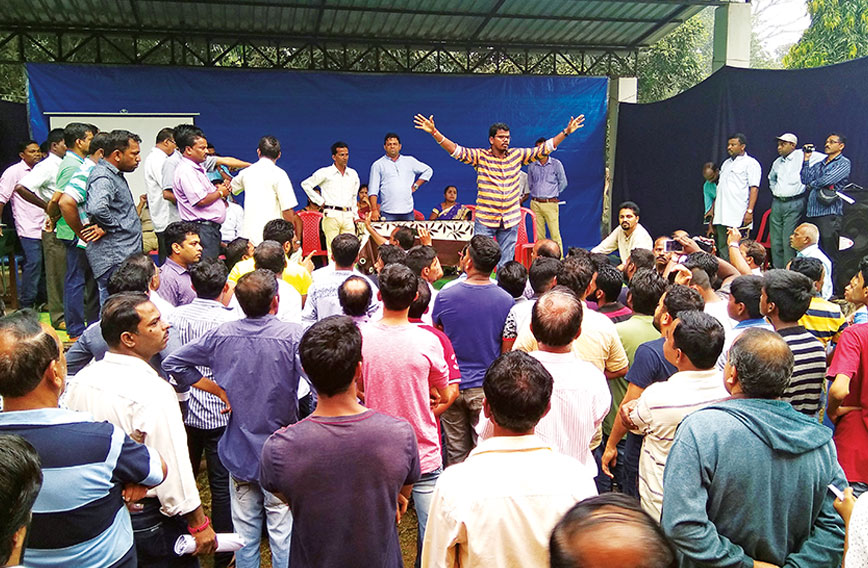 Police were called in to calm tempers at a gram sabha of Bandora panchayat. People protested against the construction of a sewage treatment plant at Undir in the village
Police were called in to calm tempers at a gram sabha of Bandora panchayat. People protested against the construction of a sewage treatment plant at Undir in the village
The panchayat has the right to issue construction licences, but it cannot refuse to do so if all laws and bylaws are adhered to by the builder. This has reduced panchayats to rubber stamps of the government. Sarpanches say villages have been stripped of the authority to make a village development plan. “The village makes a development plan but the same is not reflected in the regional plan. This results in confusion at the local level,” explained D’Souza.
In Candolim village, which forms part of the world-famous beach belt adjoining Calangute, residents committed to preserving the green cover have mounted a significant legal challenge to a move by the government to completely divest the village of planning rights. In 2015, the government included the villages of Candolim and Calangute in the North Goa Planning and Development Authority (NGPDA), a move which effectively superimposes city-based rules, regulations and increased FARs for development and strips the panchayat of all powers to plan or review.
The NGPDA is controlled by the local MLA, and in December 2016 an outline development plan (ODP) was designed. When a panchayat area is brought under a PDA the regional plan, which is more stringent in protecting green cover and slopes, becomes inoperable.
A public interest petition filed in the High Court by Damiao Teles, Roshan Mathias and eight others, all from the village of Candolim, has challenged the outline development plan adopted by the NGPDA and seeks to restore the powers of the panchayat and district-level committees over the planning process.
Pranay Kamat, advocate for the petitioners, said, “The power to make development plans is vested in the panchayat, municipalities and district committees under the 73rd and 74th amendments to the Constitution and this automatically makes the Town and Country Planning Act inoperative.”
The petition seeks to uphold Article 243(G) of the Constitution which clearly states that “the state legislature, may, by law, endow the panchayats with power and authority to enable them to function as institutions of self-government and such law may contain provisions for the devolution of powers and responsibilities upon panchayats … with respect to preparation of plans for economic development and social justice.”
“What the NGPDA is doing is patently illegal,” said Kamat.
Explaining the reasons for challenging the ODP, Teles said, “We are not satisfied with the ODP. Eco-sensitive zones, slopes, paddy fields and natural cover have been shown as a settlement zone. Besides, the NGPDA is seeking to construct a 25-metre-wide major district road through paddy fields and mangroves.
“When the village was brought under the NGPDA, the Candolim panchayat had objected. Now that the panchayat has shifted allegiance to the local MLA it has reversed its stance,” explained Teles.
The ODP was placed in the public domain for suggestions and objections, but no one knows if those have been incorporated. “Permissions for construction are being given even though the ODP has not been approved or notified,” alleged Teles.
A similar petition was filed by the Calangute panchayat when Joseph Sequeira was sarpanch. However, the June elections changed the political equation in favour of the local MLA and the petition is likely to be withdrawn.
Money and clout
It is often said that elections are a measure of democracy and this holds true in Goa as well. When 186 panchayats went to the polls on June 12 this year the voter turnout was 80.33 percent, a show of confidence in the panchayati raj system. But in the background, MLAs were at work to get people of their choice elected in every panchayat, even though panchayat polls are on a non-party basis.
As the Chandor, Candolim and Carmona examples show, MLAs and the government want to have complete control over the development process and the only way to do so is by having a firm grip on panchayats so that they can then be used to manipulate the gram sabhas, which are more outspoken and rebellious.
“Panchayats in Goa do not have any powers and the government wants to suppress us and they have suppressed us,” lamented Sequeira, who was first elected a panch of the Calangute panchayat in 1988 and has been sarpanch several times.
“If the 73rd and 74th amendments to the Constitution had to be implemented in true spirit then agriculture, electricity, water resources and more would have been transferred to the panchayat. This has not happened.”
The panchayat has some powers like the authority to issue licences, certificates and no-objection certificates for water, electricity, roads and so on. But it has limited financial powers and has to approach the government for nearly every local infrastructure project.
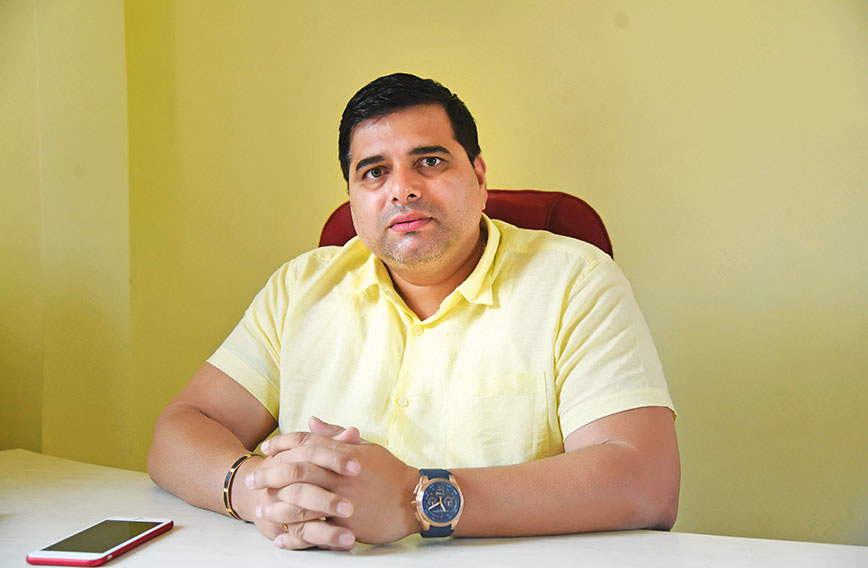 Shailendra Parulekar
Shailendra Parulekar
“Even if the panchayat wants to purchase material for street lights it has to seek permission from the Directorate of Panchayats although street lights are part of the village’s annual budget. In the case of construction of roads, we have to send the files to the block development officer (BDO) who sends them to the public works department. The BDO has the power to clear projects up to Rs 5 lakh,” says Sequeira.
Some panchayats do earn money and they can spend it on small infrastructure projects. But for anything more ambitious they have to approach the government.
The coastal panchayat of Calangute is one of the richest with an annual budget of around Rs 8 crore. Its beach is world-famous and the huge number of tourist-related enterprises generate the high revenues that it receives. Its main source of revenue is house tax and commercial licence fee which is charged on rooms let out to tourists, which is Rs 2,600 per year for each hotel room and Rs 900 for homestays.
The panchayat spends the revenue earned on widening of roads, construction of culverts, footpaths, electricity poles and lines. “We have drafted a scheme to pay poor people Rs 200 per month which has benefitted 480 persons. We are also giving disabled persons Rs 500 per month and in cases of those suffering from cancer we immediately release Rs 25,000 for check-ups. The panchayat also helps people who have suffered from natural calamities,” says Sequeira.
Despite having a huge budget, Sequeira admitted that even the Calangute panchayat is dependent on the government for certain projects. He said: “If the panchayat plans to undertake a big project like construction of a playground, football stadium or market complex, it has to send the proposal to the state government because the panchayat does not have the money.”
Some time ago the panchayat had made a budget provision of Rs 4 crore to purchase a two-bedroom flat in Parel, Mumbai, as lodging for locals undergoing medical treatment in the metropolis. “The proposal was shot down by the government,” lamented Sequeira.
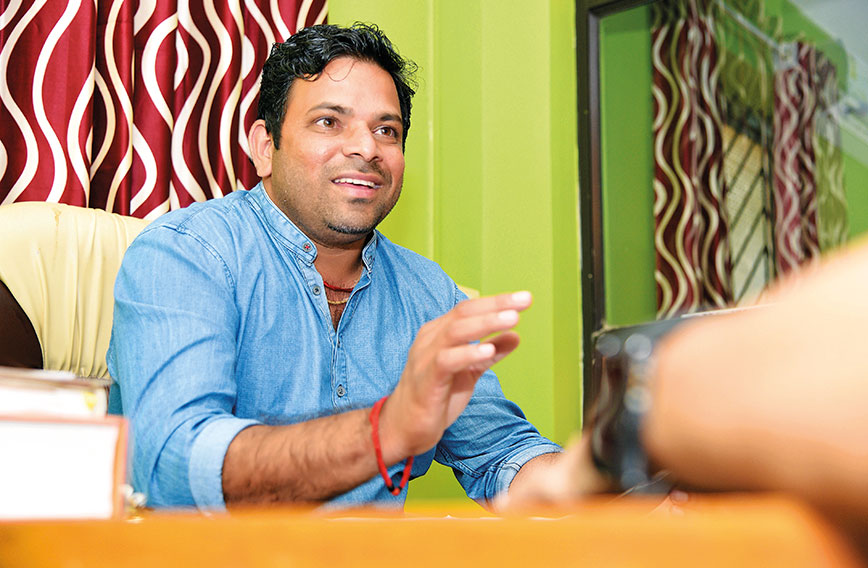 Ramchandra Naik
Ramchandra Naik
Smaller panchayats have limited resources but can’t raise revenue even if the opportunity exists. Bandora, which is located in the interior yet fairly well-developed taluka of Ponda, is one such panchayat.
The panchayat has a population of around 11,500 and is home to two state ministers. It also has three major Hindu Mutts — Naguesh Maharudra, Mahalaxmi, Ramanath Devasthan and the Sanathan Saunsta ashram. The village has major educational institutions — National Institute of Technology, Goa Engineering College and pharmacy and B.Ed colleges. All the mutts have huge halls which are leased for weddings and cultural programmes for between Rs 25,000 and Rs 30,000. Unfortunately, none of these institutions pay house tax and the panchayat is deprived of a huge source of revenue.
Even here, people have succeeded in effectively using the gram sabha to raise their voice against projects perceived as detrimental. Ramchandra Naik, a three-term elected representative and the present sarpanch of Bandora, said, “People in Ward 6 are opposing a 15-MLD sewage treatment plant. A resolution has been passed and licence issued, but the objections continue.” The Rs 44-crore plant is expected to treat waste water from residential areas of the village and a part of Ponda city.
However, Naik isn’t particularly enamoured of the notion of an independent panchayat. He says panchayats don’t have the expertise to carry out larger projects. Of course, the balance sheet of the panchayat does not quite make it easy for him to take decisions on his own. “No work will be done if the panchayat is opposed to the government,” he explained. “All the work is undertaken by the government as we do not have technically qualified persons to prepare estimates and drawings and the panchayat is just like an agency to complete the
paper work.”
Bandora receives around Rs 8 lakh through taxes, Rs 6 lakh from fees (market, construction licences, certificates) and another Rs 3 lakh as extraordinary receipts. But the bulk of the money, which is Rs 28 lakh, comes from the government through various grants and the 14th Finance Commission.
“The electricity department has started replacing street lights with LED fixtures under a central scheme, but 30 percent of the work is yet to be completed,” said Naik. “However, replacing and repairing these lights is a financial headache because we do not have the money to undertake
this work.”
The panchayat has a cattle pound but it cannot afford to hire a labourer to tend to animals or provide food if stray cows are impounded.
 Roshan Mathias and Damiao Teles
Roshan Mathias and Damiao Teles
Like most parts of the state, garbage is an issue and the panchayat spends on door-to-door collection. “We have hired a three-wheeler and two labourers to collect dry waste free of cost to residents. We even provide plastic bags,” explained Naik. “A vehicle has been provided by the minister to transport dry waste to the treatment plant at Saligao.”
Closer to Calangute is the village of Reis Magos. It is located on the northern bank of the Mandovi river and is linked to Panaji by a 10-minute ferry ride which is free for commuters and two-wheelers. With a tax base of approximately Rs 68 lakh, this panchayat should have been financially more independent than Bandora but is not, thanks to a legal system which put it firmly in the grip of the government.
“We cannot spend more than Rs 5,000 without the sanction of the government,” says sarpanch Shailendra Parulekar. “We require clearances from the BDO or the rural development agency for all projects.” He is also of the opinion that work would not get done in the village without the concurrence of the government.
But despite these constraints it has spent Rs 1.08 crore on extension of street lights, construction of roads and other public works. In 2016-17 it received grants of Rs 26 lakh from the government, all of which went on administration cost with the bulk going towards staff salaries.
“We are focused on garbage collection and disposal and last year we levied a tax for the purpose,” said Parulekar, who is a third-term elected representative. “The panchayat collects wet and dry garbage from households. The segregated garbage is sent to the Saligao treatment plant.”
Gram sabhas held by the panchayat tend to be less vociferous than in the south, but this does not stop villagers from putting their foot down when it matters. “We wanted to give permission for erection of a mobile tower as we thought it would bring more revenue but people opposed it,” said Parulekar.
At a gram sabha held in early November, a resolution was passed to reduce congestion along the river bank road. “The road is a short-cut to the coastal villages of Candolim and Calangute and tourist traffic creates congestion. We have proposed a bypass, but it is yet to be taken up by the government,” said Parulekar.
Another issue bothering the people and the panchayat is the presence of a cruise terminal at Betim in the village. “The panchayat does not earn any revenue from the jetty, but it adds to traffic congestion. The panchayat has passed a resolution to shift it.” The final decision though, lies with the government, which has not shown any inclination to undertake these two pressing demands. Even though the panchayat has erected boards banning heavy vehicles, it does not have the wherewithal to stop them.
Process and delay
The panchayats at the village level and zilla panchayats at the district level should have been linked, but have deliberately been kept apart to enable the government to have greater control, say sarpanches.
Said D’Souza, “Ideally, all files from the panchayat should have gone to the zilla panchayat where an officer connected with the various government departments would deal with them. Today, the sarpanch is marching to the agriculture department, to the electricity department and all other departments. There is no need for this. Also, all money should have been routed through the zilla parishads and not the MLAs and MPs. This would ensure accountability and transparency.”
Lamenting the reduced role of the panchayat, D’Souza said, “Most panchayats are in the grip of the MLA. You can call them an extended arm of the MLA. What are the panchayats doing now? They are only pushing subsidies, schemes and issuing certificates. This is not self-government.”
Given the manner in which panchayats have been emasculated by the government, it is not uncommon to see gram sabhas at variance with the panchayat and the government. Often, issues beyond the purview of the panchayat find resonance in gram sabhas.
Naik said, “The gram sabha should discuss development works in the village. Instead, people talk about larger projects which are outside the purview of the panchayat. People should suggest projects and we will take them forward. That is how it should work.”
Drawing attention to biodiversity committees which were recently formed in around 170 of the 191 panchayats in the state, Soter asked, “Once the people’s biodiversity register is prepared by the panels, will they be binding on all the departments? For instance, will the town and country planning department and the forest department check with the panchayat and these registers before issuing any development permission?
“Today, government departments and panchayats are accountable for the same work and are therefore working at cross purposes. When it suits the government, it will point a finger at the panchayat and the panchayat will plead helplessness when it’s convenient. So, this blame game continues.”
Another issue that comes up for criticism once in five years is reservation of seats in panchayats for Other Backward Communities (OBCs) and Scheduled Tribes, which are manipulated by MLAs to ensure defeat of political enemies. Sequeira, whose ward was reserved for an OBC candidate, thereby spelling his defeat, lamented, “There are no rules or law governing reservation for OBCs. The groundwork is undertaken by the secretary and the block development officer, both of whom are controlled by the government. This exercise should be undertaken at least three months in advance. Instead, it is declared 10 to 15 days before the elections.”
Bandora sarpanch Naik, who was also critical of the reservation system, said, “If a panch gets elected twice, it automatically makes the MLA uncomfortable.”
But despite the drawbacks of the panchayati raj system, people continue to repose faith in it and fight for a greater say in what happens in their villages, sometimes even at the cost of upsetting the government in power.
-----------------------------------------------------------------------
‘Grievances can be sent to the government’
Sandhya Kamat, Director of Panchayats, on various issues concerning panchayats in Goa.
GRAM SABHAS: According to the Goa Panchayat Act, gram sabhas are supposed to discuss issues related to the functions of the panchayat. Also, if public issues are to be raised, four days’ notice has to be given and it is the panchayat body which is empowered to list the issues to be discussed. Issues like utilisation certificates, audits, selection of beneficiaries and development work should be the priority of the panchayat. Instead, gram sabhas discuss issues not pertaining to the panchayat. Recently, coal pollution and nationalisation of rivers, which are not within the purview of the panchayat, were taken up for discussion. These grievances can be submitted to the panchayat and thereafter routed to the MLA or the government.
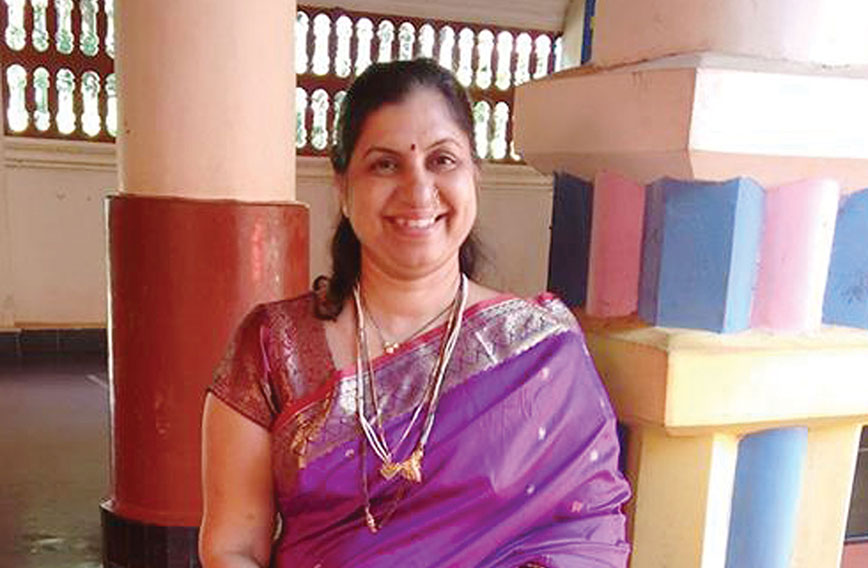 Sandhya Kamat
Sandhya Kamat
E-GOVERNANCE
At present, 125 of 191 panchayats have facilities to issue digitised printouts of birth and death certificates, but the system is yet to go online. Some panchayats have net connectivity issues and staff is yet to be fully trained. We are in the process of collecting details of all panchayats so that we can formulate a plan to take tax payments, and issuance of licences, occupancy and residence certificates and other No Objection Certificates (NOCs) online. A few panchayats have websites and online payments but to my knowledge only four or five regularly update the websites.
GARBAGE
We are supporting the efforts of all panchayats in garbage collection and disposal with grants of Rs 1 lakh each. This amount is not enough and we are planning to enhance it. We have created three categories of panchayats for distribution of funds for garbage disposal — those along the coast which have to deal with enormous amounts of garbage created by the tourism sector and therefore need more support, those around the airport will get special treatment so as to reduce bird hits, and panchayats adjacent to municipalities which have to contend with rapid urbanisation will also get enhanced support. Those panchayats doing a good job will be given incentives.
RESERVATION OF WARDS
As far as reservation for women is concerned, the wards were fixed in 2012 and they will remain so for three terms. The rules on this count are clear. In the case of Scheduled Castes, the rules state that if a panchayat has an SC population exceeding 4.5 percent then the ward with the highest SC population is reserved. At present 16 panchayats fit in this category. The problem arises with Scheduled Tribes and OBCs for whom the rules are vague. Since OBCs were not labelled in the 2011 census, reservation of seats for the 2017 polls was done on the basis of data collected from panchayat secretaries, BLOs and panchayat members. The problem with the panchayat elections is that they are held a few months after the Assembly polls and the code of conduct makes it difficult to undertake a scientific process for reservation of seats. Unfortunately, this is likely to be a problem every time, given the proximity of the dates of the two elections.
ROLE OF BDOs
The BDOs are the controlling authority for panchayats and I think that if they are given proper staff, panchayats can be run efficiently. It is true that panchayats are barred from undertaking any expenditure beyond Rs 5,000 without permission from the BDO, but we are trying to enhance this limit.
Comments
Currently there are no Comments. Be first to write a comment!



